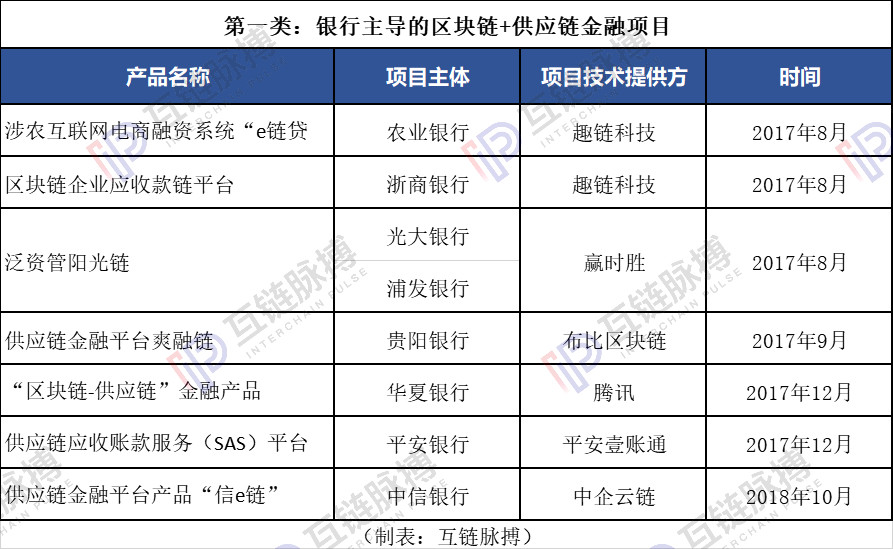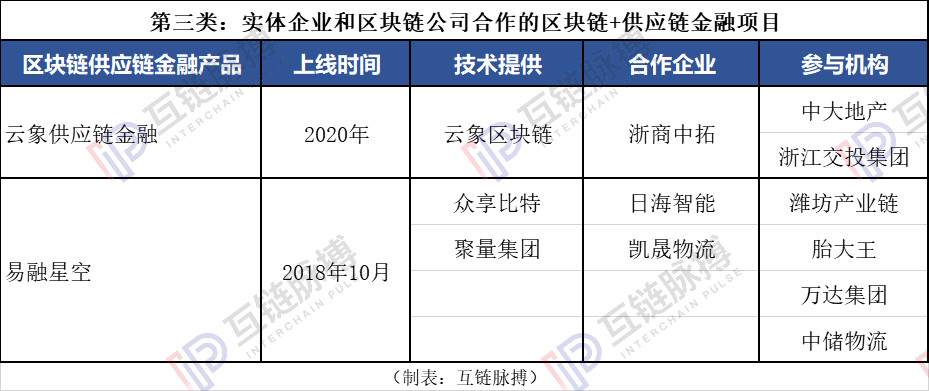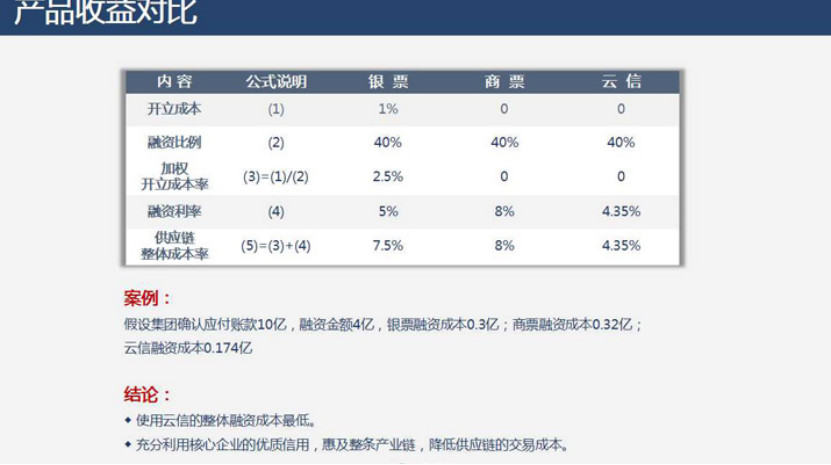With credit, there is tomorrow! 5 ways that blockchain + supply chain finance can help companies finance
Source: Pulse of Interchain, the original title "Review of Cash Flows in the Return to Work Season: Five Models of Blockchain + Supply Chain Finance to Relieve the Difficulties of Corporate Financing"
Author: Mutual chain pulse Yuan Shang
According to incomplete statistics of the pulse of the inter-chain, there are nearly 100 cases of blockchain + supply chain projects established by various institutions in China. They also played a role during the outbreak.
Money shortage + epidemic situation, enterprises, especially SMEs, are facing a life-and-death test. In addition to the central government's adjustment of monetary and fiscal policies, private forces have also added a tool—blockchain + supply chain finance.
- Babbitt Column | Interpreting Celo's "Prosperity Alliance": Is Libra's Competitor Coming?
- In the case of BTC price decline, long-term and short-term holders have not left?
- Observation | Exploration of Blockchain + Medical Supplies to Create a New Industrial Ecology
For example, during the epidemic, Beijing issued a "blockchain-based supply chain debt and debt platform", Beijing Financial Holdings released "Beijing Micro-micro Enterprise Financial Comprehensive Services", blockchain applications were launched one after the other, the former is an account based on blockchain technology Proof of the right to support the payment, to support small and medium-sized enterprises to initiate financing needs online after obtaining the right to confirm the right; the latter unites the bank to lend to medical product manufacturers.
On February 27, the chief engineer of Xunlei Chain, Lai Xin, also stated in the online event hosted by Interchain Pulse that Xunlei Chain is building a supply chain finance + blockchain platform to provide accounts receivable registration and contract Data, asset information, etc. will be chained.
The so-called "dual-chain integration" of blockchain and supply chain finance is a field where blockchain has been exploring for a long time and is the first to be expected to be industrialized. According to incomplete statistics of the pulse of the inter-chain, there are nearly 100 cases of blockchain + supply chain projects established by various institutions in China. They also played a role during the outbreak.
Five modes of subject
In the eyes of financial institutions, the information flow of business operations, logistics of goods transportation, capital flow of financial statistics, and business flow of changes in the property rights of commodities are all assets, which can be exchanged for financial assets. However, under the traditional supply chain system, such assets of the enterprise are trapped locally and cannot exchange information with other enterprises. This has caused many SMEs to be unable to judge the authenticity, reliability and value of such assets and cannot exchange them. monetary assets.
However, based on the traceability of the blockchain and the credibility of the on-chain information, where the company's assets come from, and the relationship between the assets of other companies in the supply chain are clear, credit can be extended through this chain. Therefore, more companies can exchange financial assets for more inclusive financial services. This type of service is required by enterprises on the one hand and promoted by the government on the other hand. Soon, the combination of supply chain finance and blockchain has become one of the largest scenarios for the application of blockchain, and it has an industrial prototype.
According to different entities, five modes of blockchain + supply chain finance have emerged.
In China, the early exploration of the combination of supply chain finance and blockchain was started by bankers. In 2017, Agricultural Bank, Zheshang Bank, China Everbright Bank, SPDB, Guiyang Bank, Huaxia Bank and Ping An Bank all launched blockchain-based supply chain financial products, as shown in the following table:

However, the above-mentioned projects led by the bank were thunderous and raindrops were small. After the release, most of them have not followed up. Perhaps it is because a blockchain + supply chain financial project requires subsequent efforts to operate, including contacting various parties in the supply chain, and developing on-chain system based on the characteristics of an industry. What's more important is that banks themselves are not demanders of funds, they have traditional business support, and their motivation is insufficient.
In 2018, blockchain technology companies jointly developed blockchain + supply chain financial products with Internet finance companies without commercial bank licenses. Compared with banks, Internet finance companies originally serve small and medium-sized enterprises. After the P2P business is blocked, they also need new business models.

In August 2018, Feiluo Supply Chain Finance developed by FunChain Technology, Fosun Financial Services, and Ximei Financial Services launched blockchain cooperation in the field of supply chain finance. The following month, the Cloud Elephant blockchain cooperated with Zejin Financial Services.
Blockchain companies provide technology. Internet finance companies have customers known in the physical industry. For example, Fosun Financial Services has opened the Sunshine Printing Network, Ximei Financial Services has found Zhongtian Construction, and Zejin Financial Services has joined Konka Group. Its model is to rely on core enterprises to transfer the credit of core enterprises to other SMEs through blockchain technology. Financial services companies themselves have financial support from cooperating financial factoring companies.
In fact, in this chain of supply chain finance, the value of Internet finance companies is not great. Blockchain companies and industry leaders directly dock, and then the gold master can solve the problem. Therefore, after 2018, there are more blockchain + supply chain financial projects led by industrial companies.

For example, at the beginning of this year, Zheshang Zhongtuo and Yunxiang Blockchain cooperated to rely on Zheshang Zhongtuo's core enterprises to cooperate with Zhongda Real Estate and Zhejiang Jiaotong Group to solve corporate financing issues.
Last year, Zhongxiangbit and Juliang Group cooperated to launch Yirong Xingkong's Blockchain + Supply Chain Financial System. According to reports, the system has a large number of cooperation units, including large e-commerce platforms such as Wanyitong and Nantong Galaxy; With Guoxin Cloud Services, Nanda Blockchain Research Institute and other Internet of Things technology research institutions; with tire kings, Wanda Group and other traditional industrial enterprises; with China Storage International Logistics and other logistics companies.
Some other physical enterprises even develop blockchain technology by themselves and establish a blockchain + supply chain financial platform. The more representative ones include China Enterprise Cloud Chain and State Grid.

China Enterprise Cloud Chain is an 11 central enterprises, including China Railway Corporation, China Railway Construction Corporation, China National Machinery Group, Aerospace Technology, China Shipbuilding Industry Corporation, Anshan Iron & Steel, China Aluminum, COSCO Shipping, China Merchants, China Energy Construction, Railway Materials, etc. Banks, China Postal Savings Bank 2 financial institutions, Beijing Shougang, BAIC Group, Shanghai Jiushi, Xiamen International Trade, Yuntianhua, Zijin Mining, Kingdee Software, Zhidesheng, Beijing Hualian, Genting Assets 10 local enterprises, approved by the State Council A state-owned mixed-ownership enterprise approved by the SASAC.
In 2015, China Enterprise Cloud Chain launched the "cloud letter" product serving supply chain finance, and it is now quite capable. Earlier this year, Jizhong Energy Handan Mining Group issued a special supply chain asset support plan through China Enterprise Cloud Chain. The disclosed data involved 81 suppliers and over 700 business document reviews. According to data previously disclosed by Yunxin, there are more than 6,100 registered users of the platform, and the financing amount exceeds 5.5 billion yuan.
In 2019, State Grid officially established a full-time blockchain subsidiary, State Grid Blockchain Technology (Beijing) Co., Ltd., and launched blockchain + supply chain finance businesses such as "e-loan, e-ticket" . Already served the supply chain system of the State Grid. It is reported that during the epidemic, the State Grid blockchain company leveraged the multi-party collaboration mechanism of the blockchain to work with major banks to launch comprehensive solutions such as factoring financing for financing, e-commerce procurement financing for materials, and direct billing. Prevention and control enterprises provide preferential financing services. From January 30 to February 7, the blockchain-based online industry chain financial platform has released RMB 19.49 million for 5 small, medium and micro enterprises producing epidemic prevention supplies.
If we say that China Enterprise Cloud Chain and State Grid Blockchain also need the cooperation of financial institutions, then the market has another type of main body, which has technology, finance, and a controllable industrial ecology.

In October 2018, Ping An Yi Chain developed a smart supply chain finance for One Enterprise Chain, serving Ping An Group and its ecological enterprises including the Internet Finance Alliance of small and medium banks, and Chia Tai Group.
In January 2019, Alibaba Group's ant block chain + supply chain financial product "Dual Link" was launched with a high profile, and it has already served Zhongke Daqi and Hello Travel. In this outbreak, individual industrial and commercial households in Chengdu Bainaohui realized loans to Chengdu Bank through this system.
Further de-intermediation in the future?
Although there have been so many cases of blockchain + supply chain finance, according to the mutual chain pulse understanding, there are still many difficulties in solving the financing difficulties of SMEs. For example, many industries are scattered and flat, and their own chains are short (Internet companies); for example, many industries do not have absolute leaders and lack core companies (catering companies); for example, many industries are mainly using brains, with small orders but large amounts (consulting companies) )and many more. They are all difficult to join a certain blockchain + supply chain financial system.
On the other hand, the existing blockchain + supply chain system is also half-legged. The introduction of blockchain into supply chain finance will flaunt: reduce financing costs and improve financing efficiency.
From practice, the latter is indeed reached. For example, based on the trusted data of the blockchain, the funder has greatly improved the review efficiency. According to the latest case released by “Double Link”, the core enterprise on the entire link will issue a payment voucher for the payment. The suppliers at all levels will pay this payment voucher based on real trade. With this payment voucher in hand, micro-enterprises can apply for loans online from banks on the same chain. And this loan does not need to meet. There is no need to go to the counter for various procedures and cycles like the bank used to issue loans. In addition, basically all of them are online, and the efficiency is very high. The fastest can reach second-level lending. .
However, in terms of financing costs, they have not decreased much. China Enterprise Cloud Chain has done an ideal financing cost calculation. Using the cloud letter system, the overall cost is 4.35%, the regional silver ticket is 7.5%, and the commercial ticket is 8%.

However, according to a person in charge of a technology company that has been developing blockchain + supply chain finance for a long time, the system really ran, and the funder expanded its loan coverage, but the financing cost did not decrease. The main reason is that in the current blockchain + supply chain financial system, there is no shortage of related business parties, and each party has its own profit pursuit. Although the overall audit cost is reduced, it also increases system development and maintenance costs. Even with the decline in financing costs, creditors still maximize their profit margins.
To achieve greater coverage and lower financing costs, Blockchain + Supply Chain Finance also requires two major iterations.
First, the horizontal chain is added to the vertical chain. The existing supply chain is a vertical chain of an industry, such as the automobile industry, which includes the entire vehicle, parts, raw materials, sales, aftermarket, etc., is an industrial chain of automobile production and sales. If horizontal chains are added to the supply chain, such as car dealers and its advertising media companies, event companies, labor service companies that provide social security to employees, and clothing factories that produce employee uniforms, the scope of inclusive finance will Wider. Many vertical and horizontal chains can achieve a chain network through cross-chain communication, and full coverage of on-chain finance is possible.
Second, go further to intermediaries. From the foregoing changes in the main body of blockchain + supply chain finance, we can see that intermediary is in progress, such as the removal of fintech companies and technology companies. However, in the entire supply chain financial system, the largest intermediary, lenders, has not wavered. The profit obtained by the lenders is also the largest head of corporate financing costs in the entire system. In the non-blockchain system, the lenders bear the risk that the borrower cannot pay, and as the credit subject, they must ensure the safety of the funds and pay the company's fund principals. High financing costs support it to do so. With the addition of blockchain and the support of artificial intelligence and big data, the risks can be reduced, and even no money lending institution is required. Investors use this system to realize a new generation of P2P and transfer financial assets. Excluding the large intermediary of financial institutions, the financing cost of enterprises may be significantly reduced. You can see that DEFI (Decentralized Finance) is being explored on Ethereum today.
We will continue to update Blocking; if you have any questions or suggestions, please contact us!
Was this article helpful?
93 out of 132 found this helpful
Related articles
- Research | Blockchain Quantitative Product Selection Strategy
- Economic bandwidth without trust: why Ethereum is irreplaceable
- Vitalik: Ethereum state explosion problem, polynomial promise solution can solve
- How to correctly understand DAO tokens?
- Data Increment: New Business Opportunities for Enterprise Services + Blockchain
- DeFi pattern or big change, Tether announces entry into DeFi, integrates Lightning loan agreement Aave
- Is individual mining a thing of the past? Mining these coins in 2020 is still profitable






